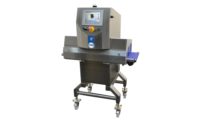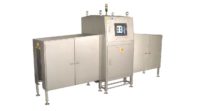Metal detectors and x-ray machines may fall into the food inspection camp, yet both are very different technologies. One uses a radio frequency transmit receive system, picking up anything that’s conductive or magnetic, the other is a density discriminator, using light frequency at high energy to pass through a product to identify mass.
Both have their pros and cons. Despite their higher price tag, x-ray machines are still considered by many as being more effective within the food inspection industry as ‘they see everything’. Steve Gidman, president of Fortress Technology, says this is a common misconception and uses the glass of water test to scientifically explain why.
“Although an x-ray machine is a density detection system, there are certain things it can’t detect in a food product. Put any contaminant you may want to identify in a glass of water and if it sinks like a stone, it’s probably going to be a detectable element. If it takes its time or floats, it’s not going to be detected by an x-ray machine.
“Wood, feathers, bugs – they’re probably the most common contaminants in the food industry, yet are undetectable with x-ray. Some metals are equally impossible to see, such as the very thin aluminum used in Soda production. If you cut a can into three or four pieces, it’s likely none of these pieces will be detectable in an x-ray machine, either inside or on top of a food product.”
Gidman confirms an x-ray will pick up the denser contaminants, such as stainless steel and ferrous, non-ferrous metals, but lighter ones, including magnesium and aluminum, and anything with a low density metal, will be difficult to detect.
“These machines may even struggle to pick up some glass and rock if they come from low-density sources. So take the glass of water test - it’ll pretty much give you the same result you can expect from an x-ray.”
He concludes, “If you’re keen to replace a metal detector with an x-ray machine, be mindful you’ll lose virtually all detection of very low-density metals unless a large ‘chunk’ presents itself. I’ve seen cases where people replace their detectors only to find half an aluminum can has passed right through their x-ray, which is a bit of a surprise.
“While this is a simple technology to understand - everyone can visualize a light patch and a beam passing through a food product, plus the machine gives a nice display of what it’s seeing - there’s a large misconception that an x-ray machine detects everything, which is simply not true.”
Fortress advocates x-ray machines should be a complimentary and secondary technology for businesses with specific needs. For instance, those where contaminants commonly used in specific types of food production do not detect well with a metal detector.
For more details, listen to the latest Fortress Technology food safety podcast featuring Steve Gidman.
For more information visit www.fortresstechnology.com.






